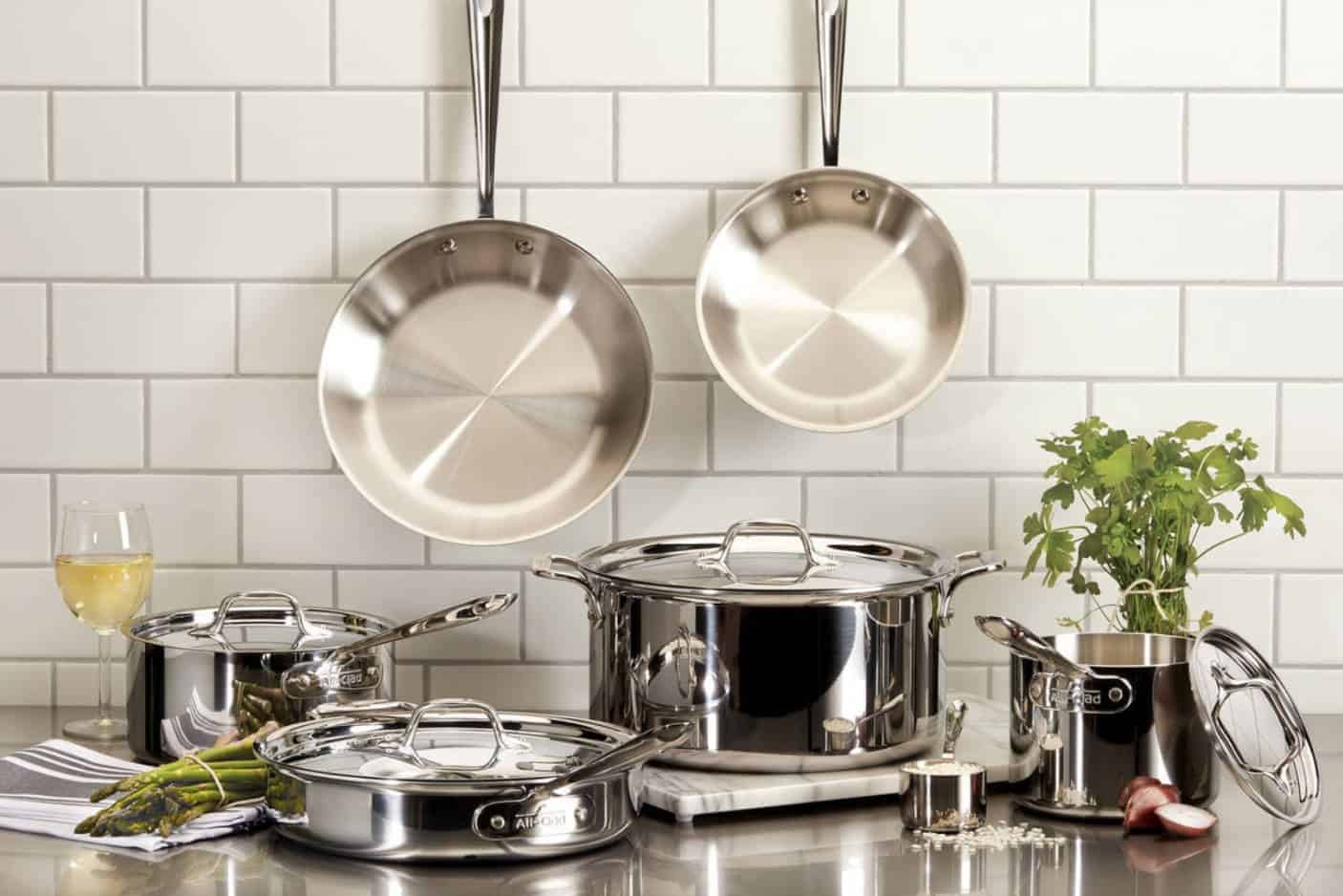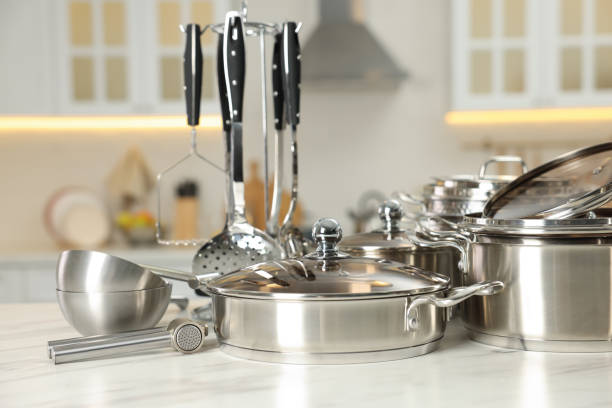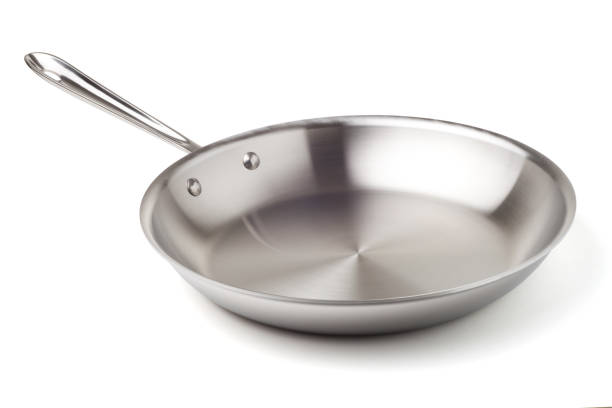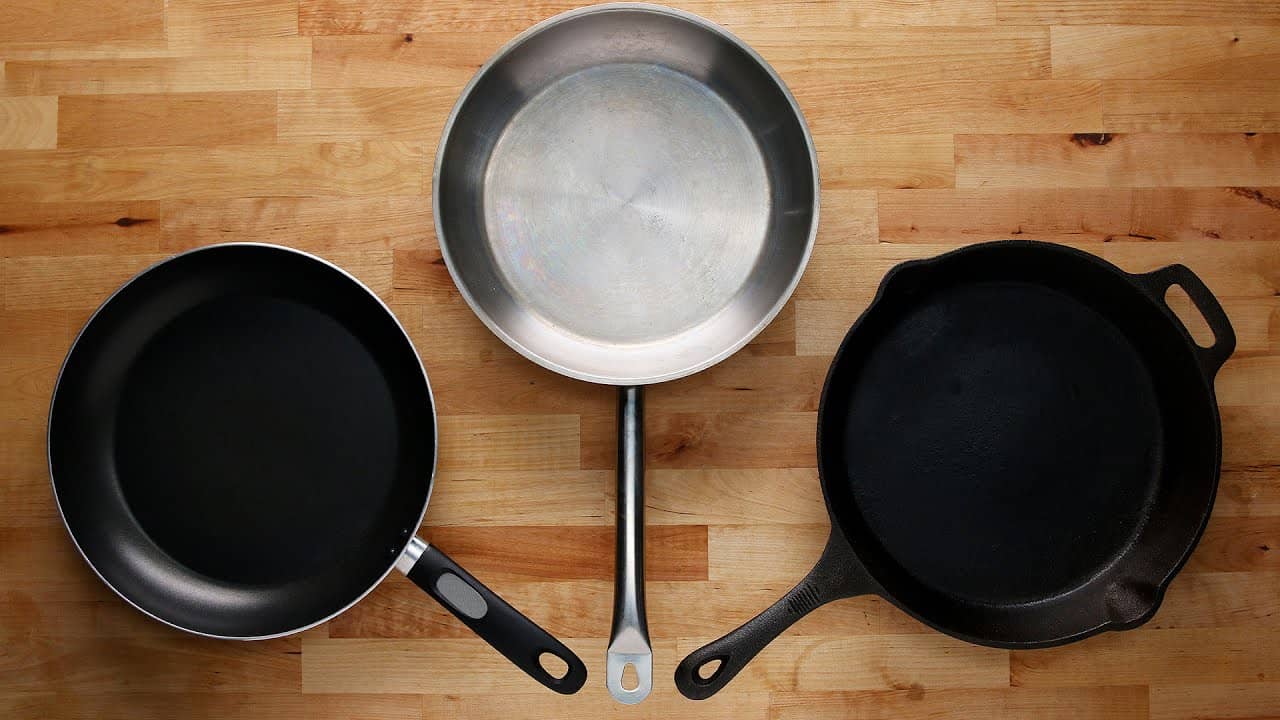In the sizzling world of culinary craftsmanship, the choice of cookware is as crucial as the ingredients themselves.
As kitchen aficionados navigate the sea of options, the question echoes: Is stainless steel cookware the unyielding knight in shining armor or a potential culinary culprit?
Delving into the realm where safety meets sophistication, this inquiry unveils the hidden secrets and gleaming truths behind the gleaming surfaces of stainless steel pots and pans.
Buckle up for a journey through the kitchen cosmos, where we unravel the mysteries and ensure that your culinary adventures are not just delicious, but also impeccably safe.

Is Stainless Steel Cookware Safe
Absolutely, stainless steel pots and pans are generally considered safe for cooking. The inherent corrosion resistance and durability of stainless steel make it a popular choice in kitchens worldwide.
People often inquire about the safety of cooking with stainless steel due to concerns about leaching metals into food. Rest assured, high-quality stainless steel cookware is designed to be non-reactive, ensuring that your meals remain free from unwanted contaminants.
When discussing the safety of stainless steel cookware, terms like “food-grade,” “non-toxic,” and “healthy cooking” frequently come up. It’s crucial to invest in reputable brands and be mindful of the nickel content in stainless steel, especially for those with allergies or sensitivities.
Is Stainless Steel Food Safe?
Yes, stainless steel is considered food-safe. Stainless steel is a popular choice for kitchenware and food containers due to its corrosion resistance, durability, and non-reactive nature.
When people ask about the food safety of stainless steel, they often use terms like “food-grade,” “safe for cooking,” and “non-toxic.” High-quality stainless steel cookware and utensils are designed to prevent leaching of harmful substances into food.
It’s important to ensure that the stainless steel used is of good quality and meets industry standards for food safety. In summary, stainless steel is generally recognized as a safe material for food contact, making it a reliable choice for various kitchen applications.
Grades of Stainless Steel
Stainless steel comes in different grades, each with specific properties suited for various applications. The most common stainless steel grades include:
- Austenitic Stainless Steel (e.g., 304, 316): Recognized for their corrosion resistance and non-magnetic properties, these grades are commonly used in kitchenware, food processing, and medical equipment. People often refer to them as “corrosion-resistant stainless steel” or “18/8 stainless steel.”
- Ferritic Stainless Steel (e.g., 430): Known for their magnetic nature and corrosion resistance, ferritic stainless steels are commonly used in automotive applications and appliances. People may describe them as “magnetic stainless steel.”
- Martensitic Stainless Steel (e.g., 410, 420): These grades are characterized by their hardness and are often used for cutlery, knives, and other applications requiring a high level of strength. Terms like “hardened stainless steel” or “knife-grade stainless steel” are used to describe them.
- Duplex Stainless Steel (e.g., 2205): Combining properties of both austenitic and ferritic grades, duplex stainless steels offer enhanced strength and corrosion resistance. People may use terms like “duplex steel” or “corrosion-resistant duplex” when discussing these grades.
Health Concerns
When discussing stainless steel and health concerns, it’s crucial to address specific aspects related to the composition of stainless steel and potential implications. Stainless steel is generally considered safe for most cooking and food storage purposes. However, concerns may arise regarding the release of nickel and chromium, two elements present in some stainless steel alloys.
People often express worries about nickel allergies or sensitivities. Choosing stainless steel labeled as “nickel-free” or opting for high-quality cookware can mitigate these concerns. Terms like “nickel-free stainless steel” and “hypoallergenic cookware” are common in these discussions.
Chromium, another component in stainless steel, raises questions about its potential transfer into food. Stainless steel cookware is designed to be non-reactive, minimizing the risk of leaching. Terms such as “food-grade stainless steel” and “non-reactive cookware” are frequently used to describe stainless steel’s safety.
Nickel Content and Allergies
The nickel content in stainless steel can be a concern for individuals with nickel allergies or sensitivities. Nickel is a common allergen, and prolonged contact with nickel-containing materials, such as certain types of stainless steel, can lead to skin reactions. When discussing nickel content and allergies, terms like “nickel-sensitive,” “nickel-free stainless steel,” and “skin irritation” often come into play.
To address these concerns, individuals prone to nickel allergies should opt for stainless steel cookware labeled as “low nickel” or “nickel-free.” Understanding the nickel composition in stainless steel, often denoted as a percentage in terms like “nickel content,” is essential for making informed choices.
Metals Leaching into Food
Concerns about metals leaching into food, especially from cookware, are prevalent, prompting discussions on kitchen safety and food contamination. Stainless steel is generally considered safe, but certain factors can contribute to metal leaching.
Terms like “corrosion-resistant cookware” and “non-reactive metals” are often used in these discussions. High-quality stainless steel cookware, properly maintained, minimizes the risk of leaching, ensuring that cooking and storage do not introduce unwanted metals into the food.
It’s crucial to be aware of specific elements, such as nickel and chromium, present in stainless steel. People commonly use phrases like “nickel leaching” or “chromium release” when expressing concerns about these elements migrating into food. Choosing cookware labeled as “food-grade stainless steel” and understanding its composition can help mitigate these worries.
Role of Chromium in Stainless Steel
Chromium plays a crucial role in stainless steel, contributing to its corrosion resistance and durability. Stainless steel is an alloy composed of iron, chromium, nickel, and other elements. The presence of chromium, typically in amounts of at least 10.5%, forms a protective oxide layer on the surface of the steel. This layer, commonly referred to as the “passive layer,” acts as a barrier against corrosion, rust, and staining.
When discussing the role of chromium in stainless steel, terms like “corrosion resistance,” “passivation,” and “protective layer” are frequently used. The passivation process involves the spontaneous formation of this chromium oxide layer when the stainless steel is exposed to oxygen, preventing further oxidation and ensuring the material’s longevity.
In addition to corrosion resistance, chromium enhances the overall strength and hardness of stainless steel. People often use phrases like “hardened stainless steel” or “chrome steel” when highlighting these properties.
Is there lead in stainless steel pans?
High-quality stainless steel pans are typically free of lead. Stainless steel itself is an alloy composed primarily of iron, chromium, nickel, and other elements. Lead is not a standard component in stainless steel formulations used for cookware. Manufacturers adhere to strict standards to ensure that their stainless steel products, including pans, meet health and safety regulations.
However, it’s essential to note that the safety of stainless steel pans depends on the specific grade and quality of the material. Cheaper or lower-quality stainless steel may contain impurities, but reputable brands prioritize producing cookware that meets food-grade standards and regulations.
When discussing the safety of stainless steel pans, terms like “food-grade stainless steel,” “lead-free cookware,” and “high-quality stainless steel” are commonly used. Choosing cookware from trusted brands and confirming its compliance with safety standards can help ensure that stainless steel pans do not contain lead and are safe for cooking.
Risks from Overheating
Overheating stainless steel cookware can pose certain risks, and it’s essential to be mindful of these potential issues. When discussing the risks associated with overheating, terms like “thermal degradation,” “metal leaching,” and “safety concerns” often come up.
One risk is the possibility of thermal degradation, where extreme temperatures can affect the structural integrity of the stainless steel. This can lead to warping or, in extreme cases, the release of metals into the food. People may express concerns about “cookware integrity” and “structural damage” in these discussions.
Metal leaching is another concern when stainless steel is subjected to very high temperatures. This can result in the transfer of elements like nickel and chromium into food. Phrases such as “metal migration” and “leaching risk” are commonly used when describing this potential issue.
To mitigate these risks, it’s crucial to follow manufacturer guidelines regarding the recommended temperature range for the specific stainless steel cookware. Terms like “temperature limits” and “safe usage guidelines” are often emphasized. Promptly addressing any signs of warping or discoloration in the cookware is essential to ensure its continued safety.
Are Scratched Stainless Steel Pans Dangerous?
While scratched stainless steel pans are not inherently dangerous, they can raise concerns depending on the severity of the scratches and the maintenance of the cookware. When discussing scratched stainless steel pans, terms like “surface damage,” “metal exposure,” and “safety precautions” often come up.
Minor surface scratches may not pose significant risks, but deep scratches could compromise the protective layer of the stainless steel, potentially leading to issues like corrosion or the release of metals into food. People may express concerns about “corrosion risk” and “metal leaching” when discussing scratched cookware.
To minimize potential risks, it’s advisable to follow proper care and maintenance practices, avoiding the use of abrasive cleaning materials that can exacerbate scratches. Terms such as “gentle cleaning,” “non-abrasive tools,” and “cookware maintenance” are often emphasized.
Regularly inspecting scratched areas for signs of deterioration and addressing any concerns promptly is essential. While not inherently dangerous, being cautious with scratched stainless steel pans and using terms like “careful maintenance” and “monitoring for damage” ensures a safer and more reliable cooking experience.

How to Use and Maintain Stainless Steel Cookware
Proper use and maintenance of stainless steel cookware are essential for ensuring longevity and optimal performance. When discussing how to use and maintain stainless steel cookware, terms like “seasoning,” “cleaning tips,” and “preventive care” often come up.
- Seasoning: While not as crucial as with cast iron, some cooks recommend seasoning stainless steel pans by heating a small amount of oil in them before the first use. This can help create a non-stick surface and enhance the cooking performance.
- Preheating: Preheat stainless steel pans on medium heat before adding cooking oil or ingredients. This promotes even heating and reduces the chances of food sticking to the surface.
- Cooking Utensils: Use wooden or silicone utensils to avoid scratching the stainless steel surface. Metal utensils can cause damage, potentially compromising the non-reactive properties of the cookware.
- Cleaning: Clean stainless steel cookware promptly after each use to prevent food residues from hardening. Use a non-abrasive sponge or cloth and mild detergent. Terms like “gentle cleaning,” “non-abrasive cleaners,” and “stainless steel-safe detergents” are relevant in these discussions.
- Avoiding High Heat: While stainless steel is durable, avoid cooking on extremely high heat for extended periods, as this can potentially lead to overheating issues, such as warping.
- Regular Inspections: Periodically inspect the cookware for scratches, discoloration, or signs of wear. Address any issues promptly to maintain the integrity of the stainless steel.
- Storing Properly: Store stainless steel cookware properly, avoiding stacking if possible, to prevent scratches. If stacking is necessary, use protective layers between the pieces.
Health Advantages of Stainless Steel
The health advantages of stainless steel extend beyond its sleek appearance and durability. Stainless steel is a preferred material for various applications, including cookware and medical instruments, due to its inherent properties.
One notable benefit is its non-reactive nature, ensuring that it does not leach harmful substances into food, making it a safe choice for cooking. Stainless steel’s resistance to corrosion and bacteria growth makes it easy to clean and maintain, promoting food safety and hygiene.
This corrosion resistance is particularly essential for individuals with nickel allergies, as high-quality stainless steel can be crafted to minimize nickel exposure. The absence of coatings or reactive materials contributes to stainless steel’s health advantages, as it eliminates the risk of potentially harmful chemicals leaching into food.
Overall, the health-conscious properties of stainless steel make it a reliable and safe choice for a variety of applications in daily life.

What Are the Safest Brands of Stainless Steel Cookware?
Determining the safest brands of stainless steel cookware involves considering factors such as material quality, manufacturing processes, and adherence to safety standards. While individual preferences may vary, several reputable brands consistently prioritize producing safe and high-quality stainless steel cookware. Some of these brands include:
- All-Clad: Known for its premium quality and durability, All-Clad produces stainless steel cookware with a focus on craftsmanship and performance. Their products are often praised for their even heating and excellent build.
- Cuisinart: Cuisinart offers a range of stainless steel cookware lines, known for their reliability and affordability. The brand is widely recognized for producing durable and well-designed kitchen products.
- Calphalon: Calphalon’s stainless steel cookware lines are appreciated for their durability and performance. The brand is committed to using high-quality materials and innovative design, ensuring safety and longevity.
- Tramontina: Tramontina produces stainless steel cookware with a reputation for quality and affordability. Their lines often feature a range of cooking essentials, and the brand is known for its commitment to responsible manufacturing practices.
- Made In: Specializing in premium cookware, Made In offers stainless steel options known for their craftsmanship and attention to detail. The brand prioritizes transparency in manufacturing and sources high-quality materials.
What Are the Alternatives to Stainless Steel Pots and Pans?
Several alternatives to stainless steel pots and pans are available, each with its own set of characteristics and benefits. Common alternatives include:
- Nonstick Cookware: Featuring a nonstick coating, these pans are easy to clean and require less oil for cooking. However, it’s important to choose high-quality, PFOA-free nonstick options to avoid potential health concerns.
- Cast Iron Cookware: Known for excellent heat retention and durability, cast iron pans develop a natural nonstick surface over time. Regular seasoning is essential for maintenance, and they may be heavier than stainless steel.
- Copper Cookware: Copper pans offer rapid and even heating, providing precise temperature control. However, they require careful maintenance to prevent tarnishing, and they are often lined with other metals to avoid potential health risks associated with direct copper contact.
- Aluminum Cookware: Lightweight and affordable, aluminum pans heat up quickly. However, some concerns exist about aluminum leaching into food, particularly when cooking acidic dishes. Anodized aluminum options provide a more stable surface.
- Ceramic Cookware: Ceramic pans are non-reactive and free of potentially harmful chemicals. They have a smooth, nonstick surface, but durability can vary, and care must be taken to avoid chipping.
- Carbon Steel Cookware: Similar to cast iron, carbon steel pans offer excellent heat retention and develop a natural nonstick layer with seasoning. They are lighter than cast iron but may require more maintenance.

Frequently Asked Questions About Stainless Steel Cookware Safety
Is stainless steel cookware safe for everyday use?
Absolutely! Stainless steel cookware is not only safe but also a popular choice for daily cooking. Its non-reactive nature ensures that your food remains free from any harmful substances, providing a healthy cooking experience.
Can I trust stainless steel cookware to keep my food uncontaminated?
Certainly! Stainless steel is known for its corrosion resistance and inert properties, making it a reliable choice. You can trust it to maintain the purity of your ingredients without any risk of leaching harmful elements into your food.
Is there any health concern associated with using stainless steel cookware?
No worries! Stainless steel cookware is considered safe for health. It doesn’t react with acidic or alkaline foods, ensuring that your meals remain untainted. You can cook with confidence, knowing that your health is in good hands.
Are there any potential hazards with using stainless steel in cooking?
Rest assured, stainless steel is a safe material for cookware. It is free from harmful coatings or chemicals, and its durability and resistance to scratches make it a low-risk option. Cooking with stainless steel poses no significant hazards.
Can I cook acidic dishes in stainless steel without any concerns?
Absolutely! Stainless steel’s resistance to corrosion makes it ideal for cooking acidic dishes like tomato-based sauces or citrus-infused recipes. You can enjoy a wide range of flavorful meals without worrying about any adverse reactions.
Is it safe to use stainless steel cookware for high-temperature cooking?
Absolutely safe! Stainless steel can handle high temperatures without releasing any toxic fumes or compromising its structural integrity. It’s a versatile and durable choice for various cooking techniques, including searing and browning.
Is stainless steel cookware a sustainable and eco-friendly option?
Certainly! Stainless steel is known for its recyclability and longevity. Choosing stainless steel cookware means making an environmentally friendly choice. It’s a durable material that reduces the need for frequent replacements, contributing to a sustainable kitchen.
Can I use stainless steel cookware on different stovetops without any issues?
Certainly! Stainless steel cookware is compatible with various stovetops, including gas, electric, and induction. Its versatility makes it a convenient option for different cooking environments, providing you with flexibility and ease of use.
Are there any special maintenance requirements for stainless steel cookware?
Not really! Stainless steel is easy to clean and maintain. You can use regular dish soap and warm water to keep it in top condition. Its resistance to rust and stains makes maintenance a breeze, ensuring a long-lasting and hassle-free cooking experience.
Is there any evidence that stainless steel cookware can impact the flavor of my food?
No need to worry! Stainless steel is non-reactive, meaning it won’t affect the taste of your dishes. Your culinary creations will maintain their original flavors, allowing you to savor the true essence of your recipes when cooked in stainless steel cookware.
Conclusion
In conclusion, stainless steel cookware stands out as a safe and reliable choice for culinary enthusiasts. Its inherent properties make it resistant to corrosion, rust, and staining, ensuring durability and longevity.
Moreover, stainless steel does not leach harmful substances into food, making it a hygienic option for cooking. While some concerns may arise regarding the potential release of nickel and chromium in trace amounts, extensive research and regulatory standards support the overall safety of stainless steel cookware.
By maintaining proper care and usage practices, individuals can confidently embrace the benefits of stainless steel, appreciating not only its safety but also its versatility and aesthetic appeal in the kitchen.